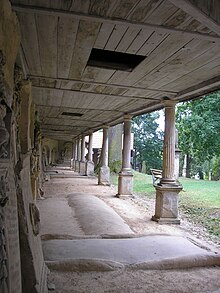Camposanto (cemetery type)
Camposanto ( Italian "holy field") is the Italian name for cemetery , especially for the courtyard-like, enclosed design with an inwardly open arcade . The best known is the next to the cathedral in Pisa located Monumental Cemetery , the 1278 to 1283 by Giovanni di Simone built and in the 14th and 15th century with frescoes was decorated. Among other things, it served as a model for the Sebastianfriedhof in Salzburg (1595 to 1600).
As a result of the Reformation , such cemeteries were created in the 16th century, especially in Central Germany : Leipzig (1536), Arnstadt (1537), Altenburg (1552), Buttstädt (1592), Eisfeld (1554), Eisleben (1538), Gera (1556), Halle (1594), Saalfeld (1553), Weida (1564). With the exception of the Hallesches Stadtgottesacker , the Eislebener Kronenfriedhof and the Buttstädter Gottesacker, nothing or only a few remains of these have survived. The reformer Martin Luther gives in his writing whether one should flee from death the advice to move the cemeteries away from the church. These burial places were then called Gottesacker. The term Camposanto was first used in the 19th century , but then referred to a special design based on the Italian model. The separation of church and cemetery also changed the legal situation. Now the city and no longer the church was responsible for the construction and maintenance of the cemeteries. A second reason for moving away from the church, which was in the center of the settlement, to outside the city walls, was the fear of epidemics, especially during the Thirty Years' War .
Preserved Camposanto cemeteries
(Selection)
Germany:
- Aachen: Westfriedhof , 1899–1905
- Buttstädt: Old Cemetery , 1592
- Dresden: New Annenfriedhof , 1875
- Halle (Saale): Stadtgottesacker , 1594
- Lindau: Old Cemetery , 1516
- Lutherstadt Eisleben: Kronenfriedhof , 1533
- Munich: Alter Südfriedhof , 1819
- Munich: Alter Nordfriedhof (Munich) , 1866
- Pforzheim: main cemetery , 1914–1917
- Teisendorf (Berchtesgadener Land): cemetery at the parish church of St. Andreas, 1815–1820
- Wangen im Allgäu : Old Cemetery , 1521
Other countries:
- Bologna, Italy: Cimitero Monumentale della Certosa di Bologna , created in 1801 through the renovation of a Carthusian monastery
- Jelenia Góra (Hirschberg in Silesia), Poland: Gnadenkirchhof , 1709
- Pisa, Italy: Camposanto , 1278-1283
- Rome, Italy: Campo Santo Teutonico , 787
- Salzburg, Austria: Sebastiansfriedhof , 1595–1600
- Steyr, Austria: Taborfriedhof , 1584
Individual evidence

